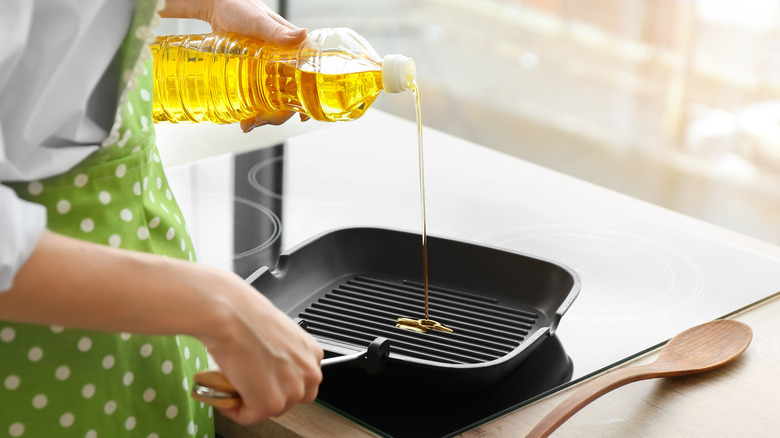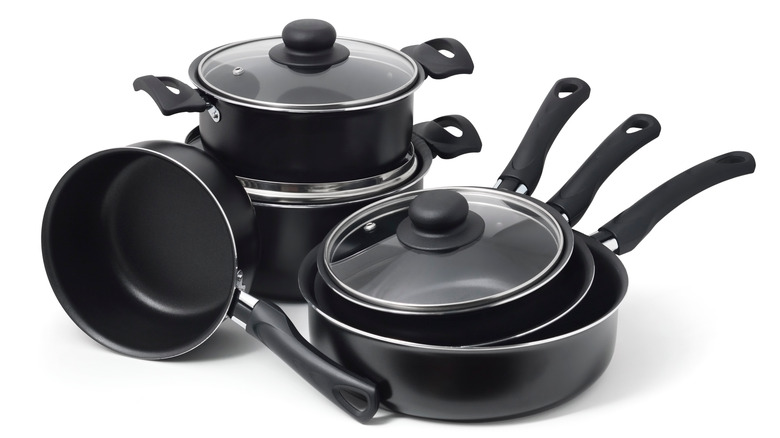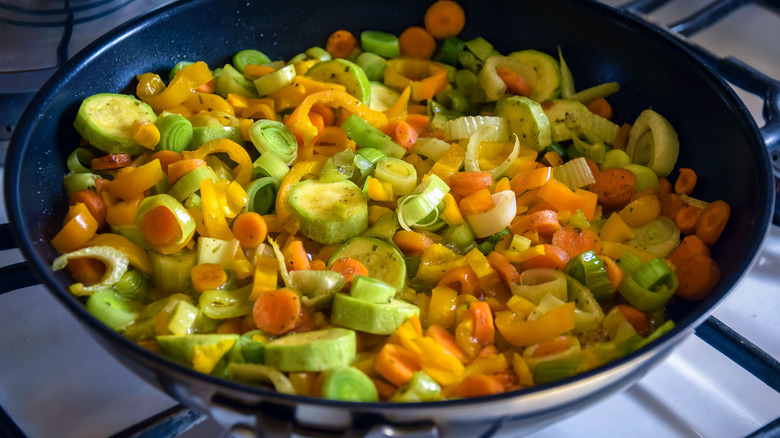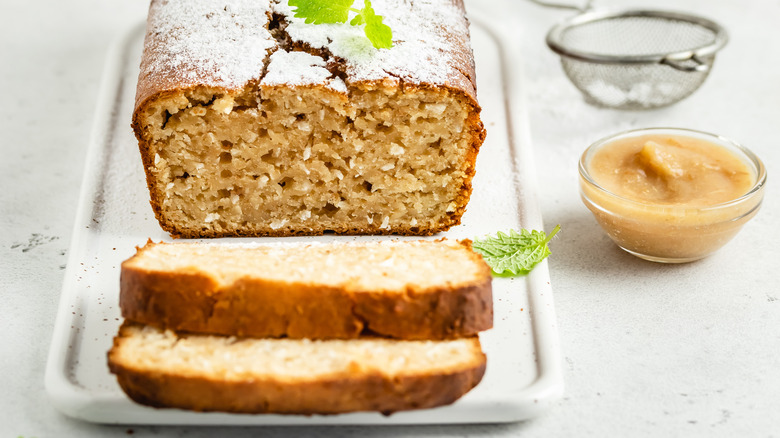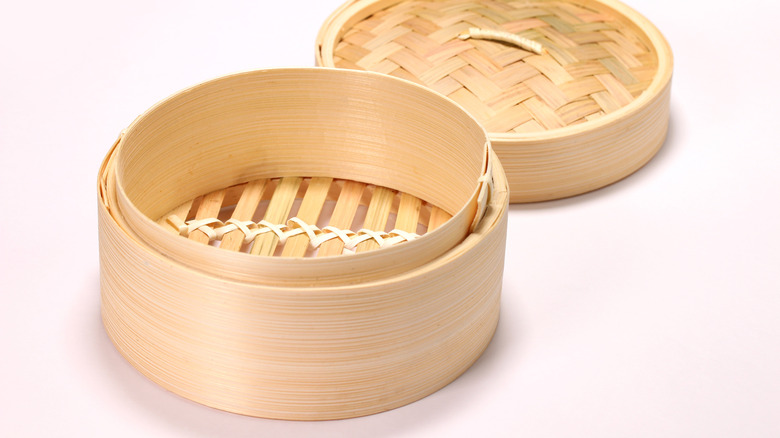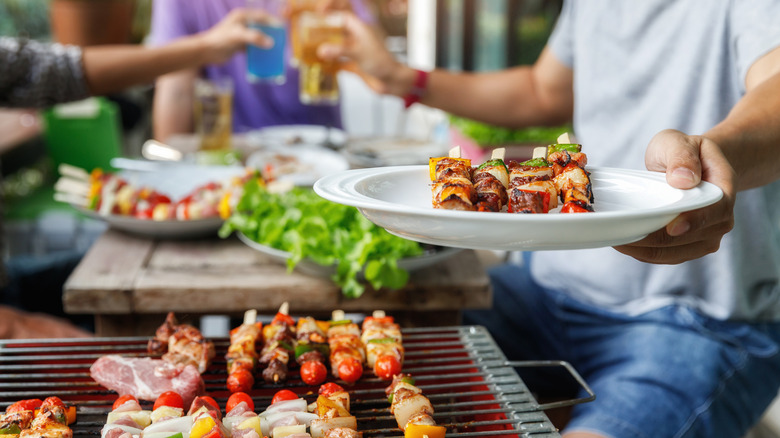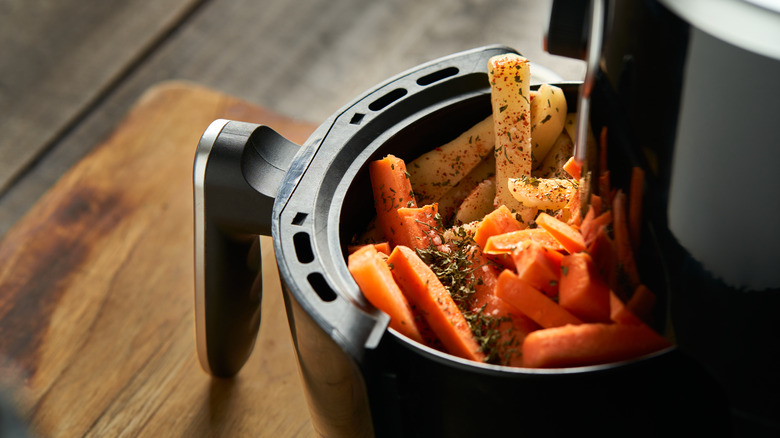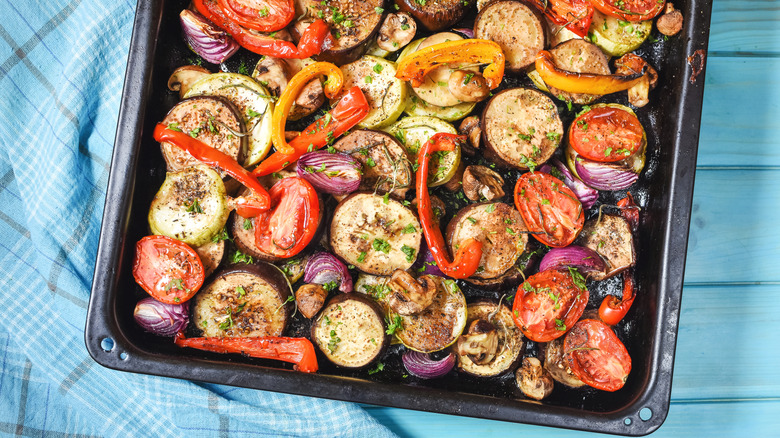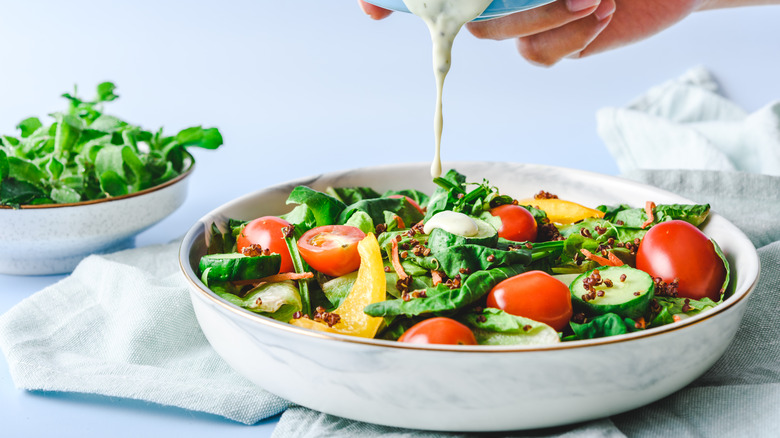Cooking Tips For Using Less Oil
Unlike your cryptocurrency nest egg, you can always count on grocery store prices to go up and up and up. Beating back rising costs on everything from fixer-upper homes to Crisco is the epic battle of our times, and in that struggle, using less of anything is a good idea.
It may seem like a small step, but using less cooking oil has benefits beyond saving a few bucks. For those with sustainability on the brain, using less oil is an opportunity to reduce cooking waste, which is a major concern according to research published in the Nature Public Health Emergency Collection. Using less oil when cooking also tends to be better for you. Unfortunately, many cooking oils are highly processed, and the level of processing can significantly affect nutritional value (via Healthline). Studies have associated vegetable oil consumption with higher rates of unhealthy inflammation and a higher risk for heart disease. Incidentally, if you are looking for the healthiest type of cooking oil, research reported by Time suggests extra virgin olive is a healthy choice, as it's filled with beneficial antioxidant compounds.
Fortunately, using less oil for cooking is pretty rudimentary. By employing nonstick pans, sautéing with stock, swapping oil substitutes in baking or steaming, and taking several other steps, you can significantly reduce your cooking oil usage. You'll cut costs, eat more nutritiously, and help reduce waste on the planet in the process.
Use non-stick pots and pans
The most straightforward way to cut back on cooking oil is to use nonstick pots and pans. While you could technically cook in nonstick cookware without any oil, doing so tends to degrade the nonstick coating (via World of Pans).
If you don't own nonstick cookware, or the nonstick pans you have aren't doing the trick anymore, going this route will require a little investment. Fortunately, Forbes writes that cookware sets from brands like Farberware can be very affordable. Lower-cost pans may be smaller, include fewer pieces, or feel slightly flimsy, but they can be a great starter set that provides excellent value.
If your focus is on getting healthier and not necessarily on saving money, you could get fancier and splurge on a premium set from All-Clad or Le Creuset. In addition to reducing the need for cooking oil, these high-end cookware sets are also made without PFOA. This non-stick substance has been associated with a higher risk of certain cancers (via the American Cancer Society).
Sauté with stock or water
Per definition from The New York Times, sautéing involves the transfer of heat from a pan to food, usually with the help of liquid fat. The term sauté comes from the French term for "jump," and the technique likely got its name from how foods will jump — or sizzle — inside a hot pan.
When many of us look to make a searing sauté dish, the first instinct is to reach for a bottle of cooking oil. However, according to Vegan Coach, a ¼ cup of stock or water can help to lubricate food in a nonstick pan in the same way as cooking oil.
If you're going to sauté with stock or water, placing a lid on the pan can help cook your food more evenly than direct heat. Technically, covering a pan leads to cooking with steam rather than the direct heat of hot stock (or oil), which can lead to a loss of the crispiness or crust that comes with sautéing.
If you want both the even cook that comes with steaming while still getting crispiness, you need to remove the lid just after your dish appears cooked through. Start tossing your food to ensure it gets enough direct heat from the liquid and the pan. Adding a bit of oil can help here. If the food starts to stick, a few splashes of additional liquid can loosen up any stuck-on bits.
Use oil substitutes for baking
Baking completely oil-free is a tricky proposition. Unlike cooking, baking is highly dependent on getting the right ratios of fats, protein, and other ingredients. Because so many baking recipes use oil as a load-bearing wall — swapping it out for something else can collapse a baked good's culinary house of cards.
Replacing oil with something healthier or cheaper requires understanding the main function of oil in baking. When dough or batter is heated to a certain point, water moves into a gaseous state. However, the inclusion of oil reduces evaporation while slowing the formation of gluten, resulting in a moist, fluffy texture. Additionally, the oil helps to bind ingredients during the baking process (via Bob's Red Mill).
One of the best oil substitutes that can model both effects is applesauce. In addition to retaining moisture and acting as a binder, applesauce is also incredibly convenient: It can be a one-for-one substitute for oil, according to LiveStrong, which recommends draining some water from the applesauce. Home cooks can also substitute other fruit or vegetable purees for oil with varying effectiveness. Other worthwhile substitutes include dairy products like butter, buttermilk, sour cream, mayonnaise, and Greek yogurt.
Switch to steam
If you have a steamer basket that you only use for specialty dishes, you should know it can do more than cook dumplings! For example, fish and vegetables can easily be cooked with a steamer and without oil.
Steaming is one of the healthiest ways of cooking. Not only does it avoid the use of oil, but steaming is also a highly nutritious way of cooking, per Tufts University. One study from the University of Illinois found steaming broccoli caused the vegetable to develop a cancer-fighting compound called sulforaphane, while boiling and microwaving broccoli did not. Another study reported by Tufts found steaming vegetables to be the only cooking method that preserves cancer-fighting compounds known as glucosinolates.
If you aren't an old hand at this technique, you should know there are a few mistakes to avoid when steaming food. First, you should not put too much water in your pan. The moisture level should be enough to keep the steamer from scorching but not so high that it boils over and touches the food inside.
Before loading up your steamer, use parchment paper, banana leaves, or liner to prevent steamed food from sticking to the basket. To ensure even cooking of every item, don't overcrowd the basket as it will keep steam from circulating.
It's common to stack up multiple bamboo steamers to cook several dishes at once. When doing this, place food with longer cook times near the bottom of the stack and closer to the direct heat (via Kana).
Make the grill a go-to
Grilling is one of those cooking techniques that require very little oil, as it's mainly used to prevent food from sticking to the hot slats. If your grill is well-seasoned, you may not need to use any cooking oil at all, especially for meats and foods with low moisture.
A nonstick grill mat can be a handy solution to completely avoid oil or cook high-moisture food like avocados or marinated vegetables. Nonstick grill mats are designed to be placed directly over a grill, and they can also help prevent food from slipping through the grates. Best of all, they don't require any major adjustments to standard grilling techniques. With vegan cooking advice from Momma Sezz, nonstick grill baskets can also allow you to cut back on oil, but cooking with them typically requires more work than simply placing food directly on a nonstick mat or grill.
If you want to cook with a backyard grill, but aren't wedded to the idea of actually grilling, putting food in foil packets with a bit of stock or water is a great way to cook without oil.
Use an air fryer
Cooking with an air fryer is a great way to use less oil, form more nutritious habits, and get crispy food. Better Homes & Gardens writes that this modern appliance is essentially a countertop convection oven. An air fryer uses quickly circulating hot air to cook food in a way that resembles deep frying. While using an air fryer can be pretty intuitive, there are a few things to keep in mind. Before you get cooking, it's important to select an air fryer that suits your needs: Don't buy a hulking behemoth of an appliance if you're living on your own. It's also a good idea to preheat an air fryer before using it to cook food. Also, occasionally shaking the basket while cooking helps evenly crisp all the contents.
While you can completely forego the use of cooking oil when employing an air fryer, using a spray bottle to spritz oil on your food halfway through cooking is a great way to ensure your food gets a solid crisp (via Today). You could also use a store-bought can of cooking spray, though the aerosols have been known to damage the nonstick coating of an air fryer basket.
When removing cooked food, separate the basket from the drawer to prevent oil from being spilled onto a serving dish or plate.
Par boil or steam before roasting vegetables oil-free
Roasting is one of those cooking techniques that causes many of us to instinctively reach out for a bottle of cooking oil. Roasting vegetables typically calls for less oil than frying or sautéing, but you can actually perform this cooking technique without any oil at all.
While non-starchy vegetables like onions only need a bit of seasoning, starchier produce like cauliflower can dry out if popped straight into the oven. An effective solution for roasting starch-heavy vegetables without oil is to par-cook them by steaming or boiling (via Well + Good). This approach asks the oven to do less of the cooking, and it infuses the vegetables with enough moisture to prevent them from drying out. As with non-starchy vegetables, be sure to season your food before finishing it in the oven. Use parchment paper or aluminum foil as a pan liner to prevent sticking.
If you would only like to cut back on oil — not remove it completely — spraying on a light coating of oil can split the difference and yield positive results.
Use plant-based alternatives in salad dressing
If you're a regular salad eater, you're probably ingesting a lot of oil in the form of salad dressing. And, if you regularly like to use bottled dressing on your salad, you're also eating a lot of saturated fat, preservatives, sodium, and added sugar. Fat-free or low-fat salad dressings may seem like a healthier option, but many of these products still contain a large amount of sugar.
A much healthier route is to make your salad dressing. While health experts at the Cleveland Clinic recommend simply pouring olive oil and vinegar over your salads, you don't need to rely on oil to make a delicious, nutritious topping for your next bowl of crunchy greens.
Typically, types of salad dressing recipes are a combination of oil (or another fatty liquid), acid, sweetener, and flavorings. Instead of using oil, consider that nut butters, miso, and hummus make great salad dressing foundations. You can also base your dressing on pureed nuts, avocado, or cannellini beans — as with these tips from Plant-Based Cooking with Diane Smith. Once you have your creamy or pureed oil alternatives, you simply need to whisk them with your other ingredients.
